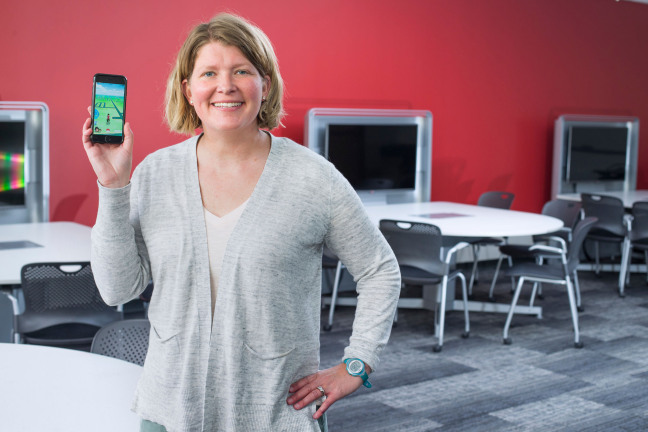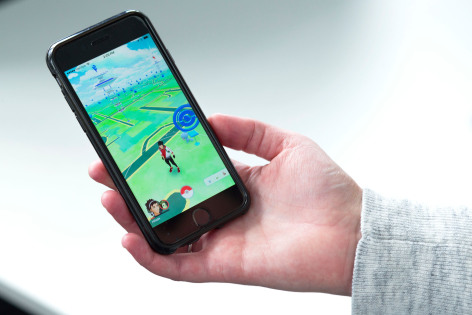
Emily Howell encourages teachers to use Pokémon GO in the classroom to help students build multimodal communication skills. (Larger image) Photos by Christopher Gannon
AMES, Iowa – Technology continues to change the way students learn and engage with their peers, parents and community. That is why Emily Howell, an assistant professor in Iowa State University’s School of Education, is working with teachers to develop new ways to incorporate digital tools in the classroom, including playing games such as Pokémon GO.
The focus of Howell’s work is two-fold – to give students equitable access to technology and help them build multimodal communication skills. That means not only using technology to consume information or replace traditional classroom tools, but experimenting with new forms of communication, she said. Instead of having students read a book on a tablet or use the computer to type an assignment, they need to learn how to create and upload videos or build graphics and maps to convey their message.
Howell’s suggestion of having students play Pokémon GO to build these skills may seem a bit unconventional. However, after playing the smartphone game with her own children, she saw how it could help students with writing and research in ways that align with Common Core standards. Howell says engaging students through Pokémon GO, a game many are already playing outside the classroom, also generates interest and connects students to their work.
“It is important to give students authentic choices that really have meaning in their lives,” Howell said. “We need to encourage them to develop questions, research the answers and then share that information in writing.”
For example, a common assignment is to have elementary students write an essay on how to make a peanut butter and jelly sandwich – a task students can easily explain, but not a genuine question many have, Howell said. Pokémon GO, like many video games, provides players with limited information or what Howell describes as “just in time learning.” As a result, players have questions about how to use certain tools or advance to the next level.
Playing the game with her own children, Howell watched their enthusiasm in researching and finding the answers to these questions. They were even more excited to share their knowledge with her and their grandmother, who was also playing the game. In a paper published in the journal The Reading Teacher, Howell explains how teachers can have students identify questions about Pokémon GO, find the answers and present their findings in different formats.
Using different modes of communication

Pokémon GO incorporates different modes of communication – gestures, visuals and directions – which makes it a good fit for the classroom, Howell said. Players see the character on their phone, the character is integrated into a map and the player controls catching the character. Pokémon GO illustrates the need to understand multimodal text, which reflects how we communicate with others, she said.
“We don’t just send a text or email; we have a live chat or video conferences. Anytime teachers can find something that students are already doing, and comes in multimodal form, they can harness that interest and teach students about the tool’s potential,” Howell said.
Even more than conventional tools such as a paper and pen, teachers must provide a framework for using digital tools. Howell says students need to understand conventional literacy skills, but also learn how to upload files or design elements on a page that are not in a linear progression.
“It’s not just giving students the technology and letting them play, it’s really guiding that interaction so they can express meaning,” Howell said.
Providing a safe, online forum
To make the assignment even more authentic, Howell suggests giving students an outlet to share their work with people outside of the classroom. Many school districts create secure, online platforms where students can share work with family and friends and receive feedback. Knowing that others will view their work helps students develop writing styles for different audiences, not just their teacher, Howell said.
“It makes the assignment more authentic and helps with motivation and understanding the purpose for writing,” she said. “It has academic as well as social benefits.”
Howell received a grant from the Center for Educational Transformation at the University of Northern Iowa to help elementary teachers in Iowa integrate technology into their writing lessons. The goal is to engage students in writing so that they are using digital tools to create content, rather than strictly consume information.